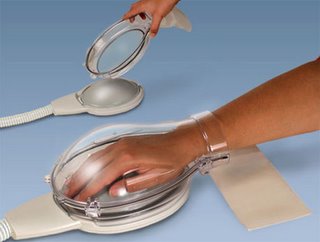New Rewarming Technology

From the San Jose / Silicon Valley Buiness Journal, based on a post at Medgadget:
The new chief executive and president of Fremont's Dynatherm Medical Inc. is making the rounds on Sand Hill Road to pitch the idea of a high tech mitt that warms hypothermic patients through a combination of heat and air. He's seeking to launch the mitt as the company's first product and tap a $1 billion-plus market.
Based on a patent developed at Stanford University, VitalHeat is deceptively simple and extremely effective, he says. A patient's hand, placed in a sealed mitt, is subjected to heat and vacuum pressure. This rapidly channels blood to a patient's vital organs, or core, spiking the body temperature by several degrees within minutes.
Mr. Christensen, a medical device veteran who was appointed in May, says the product, cleared by the FDA in the fourth quarter of 2004, is needed in frosty environs like operating rooms because the threat of hypothermia in patients undergoing anesthesia or suffering from trauma is a constant challenge for health care providers. It is not unusual for a patient's core temperature to drop several degrees during surgery, medical experts say, raising the risk of longer recovery times and other complications. Treatments to counteract the effects of hypothermia can cost hospitals up to $7,000 per patient, according to Dynatherm.
Conventional thermal technologies, meanwhile, fail to heat up patients as quickly and easily, Mr. Christensen says. Blankets made by competitors like Arizant Inc. of Eden Prairie, Minn., for instance, which blow hot air over a patient's supine body, take up to two hours and are obtrusive for doctors, he says, while treatments that involve warming patient fluids via catheters are invasive and more risky.
For Dr. Jim Watkins, forced air blankets have been the treatment of choice for combating hypothermia. But the Fresno anesthesiologist says there are certain cases, such as heart surgeries or vein harvests, where a bulky blanket isn't practical.
When Dynatherm showed Dr. Watkins its product to see if he would test it for the company, "I laughed at it," he says. "It was hard to convince me that warming a small area of the body -- 2 to 3 percent of a body' total surface -- would work."
His skepticism disappeared after a dozen trial runs. "It worked beautifully," he says. "I've chatted with several people at the hospital about [buying] the system."



0 Comments:
Post a Comment
<< Home